IVAN NIKITSKIY, EUROPEAN PHOTONICS INDUSTRY CONSORTIUM (EPIC)
Microelectronics and sensors, particularly lidar
sensors, play a pivotal role in the realm of autonomous driving and self-driving cars. The markets for these technologies exhibit substantial potential, prompting predictions that the automotive lidar market will double in size within the next two years.
Safety is a paramount concern in the automotive sector and is necessitating the deployment of high-value and high-performance lidar systems for advanced driver-assistance systems and autonomous vehicles. The existing challenges to this end revolve around the considerable size, weight, and power consumption of lidar sensor devices. Given these constraints within a vehicle platform, there is a pressing need for further miniaturization of lidar systems, coupled with improvements in their functionality and resource efficiency. While current lidar systems are often mounted externally on a vehicle, the goal is to seamlessly integrate these devices into vehicle body sections, such as bumpers, grilles, or exterior lamps.
Since 2020, automotive supplier Marelli, along with 15 partners, has participated in the European Union’s €10 million TINKER project, which was set up to create an affordable and resource-efficient method for using nanoimprint lithography methods to produce radar- and lidar-sensor packaging. Marelli’s contribution to TINKER is the integration of compact lidar systems into the vehicle’s active spaces. Sensor placement, for example, must provide a comprehensive horizontal and vertical field of view (FOV) and minimize blind spots. Also, it must provide maximum coverage of the surrounding environment, taking into consideration any complex occlusions from automotive mirrors, glass windows, and thin pillars. Additional engineering
challenges include minimizing cost, form factor, and the effect of weather and environmental conditions on lidar performance; engineers must also balance
range, accuracy, and resolution, and calibrate and synchronize lidar with other sensors and real-time data processing.
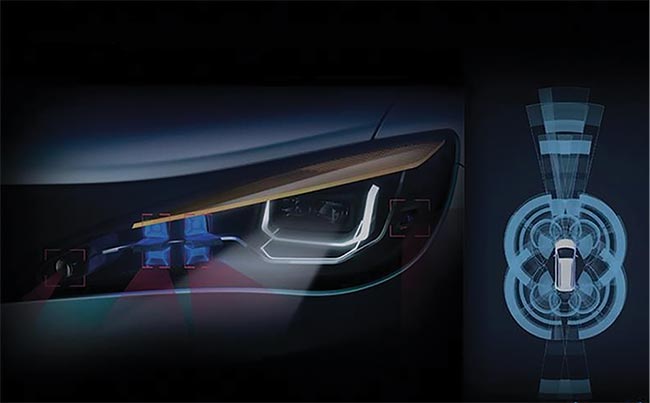
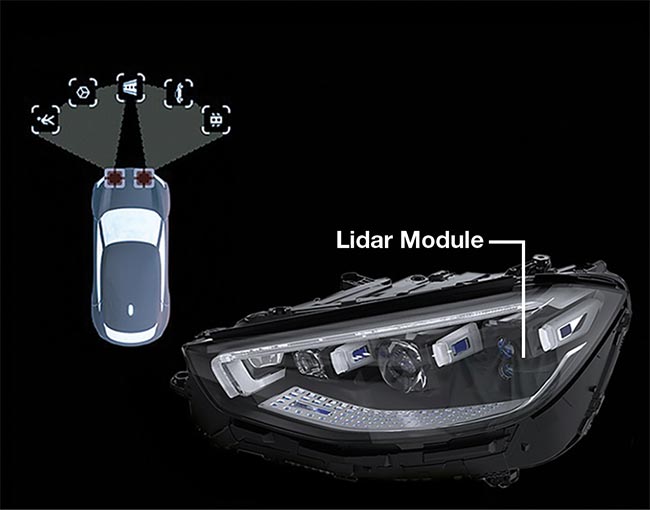
Marelli’s Smart Corner solution for integrated lidar placement in automotive headlamps. Courtesy of Marelli.
Regarding placement on the vehicle, during the next ten years, 2023 figures from the S&P Global/IHS Markit lidar database show clear favor for the center front and corner front of the car. Compared with roof- or windshield-mounted systems, the front-corner solution offers several advantages. This is due, in part, to the availability of space to accommodate more lidar sensors, which S&P forecasts will increase in number from 24 to 35 by 2035. The front-corner placement also offers better options for FOV leveling, minimizing exposure to external conditions, optimizing aesthetic integration, and incorporating cleaning, heating, and wiring systems.
Accordingly, Marelli developed its Smart Corner solution, in which head-
lamps, rear lamps, and a vehicle’s front grille incorporate panels as hosts for
sensors, radar and lidar cameras, and
illumination devices. The system can
recognize objects earlier and provide a larger sight angle than ever before.
Design and simulation
To begin building an integrated lidar system, one must first think of a specific design and then simulate it. For more than 25 years, Berlin-based VPIphotonics has established itself as a market leader in integrated and interoperable simulation software tools for photonic design and analysis. These tools include VPItransmissionMaker Optical Systems and VPIcomponentMaker Photonic Circuits, which enable hierarchical design architectures. The tools are designed so that they can be used together seamlessly.
The use of VPItransmissionMaker
Optical Systems, a mainstay in the datacom and telecom industries, shows significant parallels when applied to lidar technology due, in part, to a recent upgrade in support of free-space optical communications. The newly enhanced free-space optical channel model supports the modeling of atmospheric conditions, including weather, elevation, wind speed, and more.
The VPIcomponentMaker Photonic Circuits tool is suited for more detailed physical-level modeling of photonic integrated circuits (PICs) used for lidar applications. This tool includes models for passive and active components such as distributed feedback or distributed Bragg reflector lasers and optical phased arrays. These components can be interconnected within a PIC to enable functionalities for widely tunable hybrid III-V/silicon lasers using ring resonator sections for tuning. The software allows the combination of different material platforms to design and simulate a PIC, facilitating sensitivity analyses to investigate fabrication tolerances before the actual fabrication process begins.
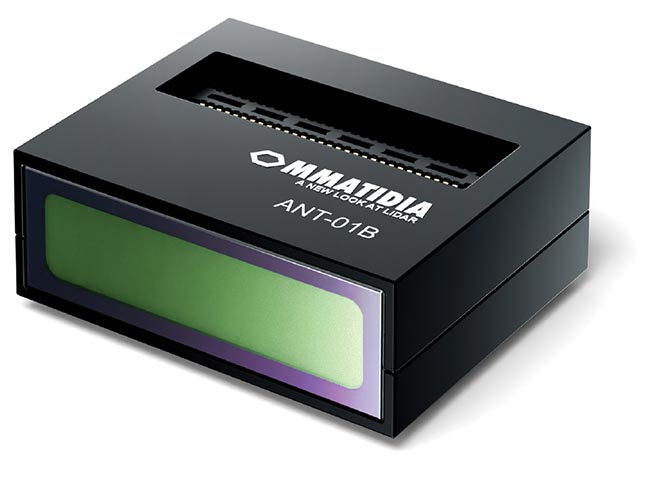
Though simple in appearance, Ommatidia’s high-resolution 3D lidar camera is based on a sensor composed of hundreds of thousands of ommatidia-like photoreceptor cells, like an insect’s eye. Courtesy of Ommatidia.
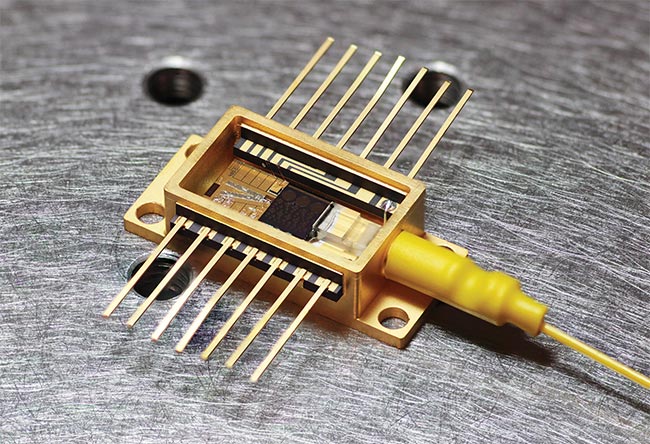
DeepLight’s hybrid integrated lasers for frequency-modulated continuous wave (FMCW) lidar systems are based on silicon nitride and MEMS actuators. Courtesy of DeepLight.
For a system-level simulation of a frequency-modulated continuous wave (FMCW) lidar, for example, the software enables modeling of the transmitter using
a simple frequency-modulated laser with a triangular waveform. The signal is then divided into a probe and a reference signal. The probe signal travels through a circulator and the free-space optical channel model, enabling analysis of the effect of various atmospheric conditions on signal attenuation. Additionally, if the target is moving, a Doppler shift can be considered. Then, the signal is reflected back through the optical channel and circulator, where it merges with the reference signal for balanced photodetection. This process allows for a systematic study of different impairments on distance and velocity measurement performance.
Lidar architecture
One interesting example of an integrated lidar architecture is provided by
Ommatidia LIDAR in Spain. Its aim is to address a fundamental performance limitation of existing lidar architectures — namely, that they restrict light emission to short pulses or concentrate photons in a particular direction. This limits the number of photons available for the return signal, which, in turn, limits range and resolution.
To address these issues, Ommatidia developed long-range, high-resolution 3D lidar cameras based on a sensor composed of hundreds of thousands of ommatidia-like photoreceptor cells, like an insect’s eye. The design enables the emission and detection of many more photons as well as unprecedented range and resolution. This novel bio-inspired architecture allows the use of continuous broad-beamed illumination of the entire scene and enables the safe use of high-power illumination for the first time in 3D imaging.
Ommatidia’s lidar scheme is based on an FMCW lidar system that provides coherent and balanced detection via amplification of a low-power sample signal by mixing it with a high-power local oscillator signal. This gives single-photon sensitivity, limited shot noise, and high distance accuracy. Furthermore, mixing only signals that share the same frequency modulation ensures immunity to interference with solar radiation, while amplitude and phase detection occur through the optical mixer.
Ommatidia’s Q1 camera has 128 parallel channels and can provide metrology-grade measurements at up to 50 m. The device includes imaging vibrometry functionality that reveals the dynamics of structures in a contactless manner without the need for costly instrumentation. The system is engineered for field use both indoors and outdoors, with IP54 protection and a rugged assembly. The next step is to bring the technology to new markets by addressing its scalability.
Source considerations
Laser sources for lidar are a rapidly evolving component technology. Swiss startup DeepLight, for instance, is developing hybrid integrated lasers leveraging silicon nitride and MEMS actuators for automotive FMCW lidar systems based on coherent detection. The approach enables the system to measure object velocity with high sensitivity, as well as with minimal interference at long ranges of >200 meters.
However, the technology requires narrow linewidth lasers and high chirp linearity — which presents a major disadvantage. In response, DeepLight is developing more easily controlled high-performing lasers based on ultralow-loss silicon nitride platforms.
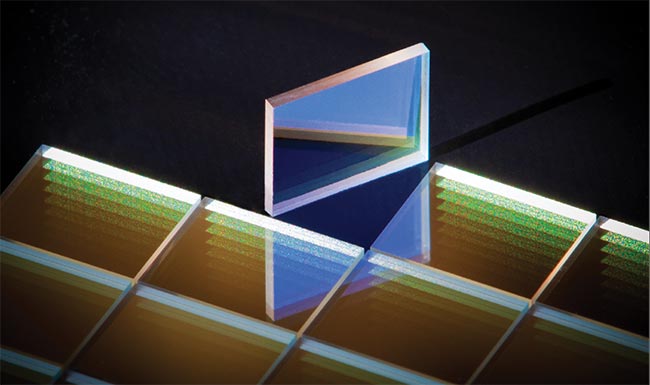
An illustration of VIAVI Solutions’ hydrogenated silicon (Si:H) filters for lidar systems. Courtesy of VIAVI Solutions.
The solution is based on three technology bricks. The first is hybrid integration of multiwavelength semiconductor lasers incorporating gain elements made from direct-bandgap III-V compounds. Second, to achieve 10× lower noise than a fiber laser, DeepLight is leveraging ultralow-loss silicon nitride to enhance the lasers’ spectral purity. The third building block is the use of MEMS-based actuators that the company monolithically integrated with silicon nitride to achieve a range of actuation in the tens of megahertz range.
Use of the three technology bricks enabled DeepLight to explore three distinct laser architectures for their system: self-injection locking of distributed feedback/Fabry-Perot diodes; extended distributed Bragg reflector lasers; and external cavity lasers.
The performance of DeepLight’s prototypes looks impressive. One exhibited 0.1% root mean square nonlinearity without any linearization or distortion at sweep rates of up to 100 kHz, which is ideal for time-resolved heterodyne beat-note measurement. With this level of performance, DeepLight’s technology is well-positioned to address lidar and a wide range of other applications.
Lidar optical filters
Optical filters are another essential component of most integrated lidar systems. Optical filters block out unwanted information caused by changing light conditions or reflections from oncoming headlights. Such conditions can affect lidar’s ability to accurately detect and measure surrounding objects, making optical filters crucial to ensuring that the system only gathers the right data from the desired wavelength of light.
An optical filter must function reliably across a variety of changing light conditions and, although a filter can sometimes be the least expensive component in a lidar system, its design and performance can have a significant effect on sensor performance. Many filters designed for lidar applications are based on alternating layers of low- and high-refractive index layers to create interference and filter the light appropriately.
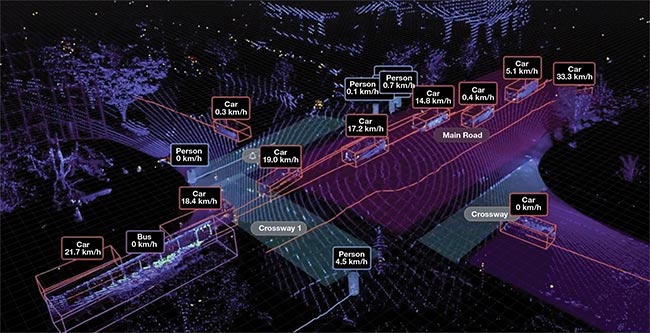
Software developer Outsight’s 3D lidar data processing solution can track people or vehicles to analyze patterns and alert end users when a particular threshold has been reached; it can detect an overcapacity in a certain location, a bottleneck in traffic, or even intersections prone to near-miss accidents. Courtesy of Outsight.
VIAVI Solutions, a leading U.S.-based optical filter supplier for lidar developers, features products constructed with hydrogenated silicon (Si:H) in its portfolio.
When used as a high-index material, Si:H offers two main benefits. Firstly, its high refractive index supports lower-cost systems. Secondly, compared with bandpass filters constructed with traditional materials, those leveraging Si:H can reduce blue shift for light rays at increasing angles of incidence. This capability increases usable bandwidth, thereby decreasing the required bandwidth overall.
As the lidar industry introduces second-generation products, their cost and performance is becoming even more critical to success. So, there is a need for narrow bandwidth systems to deliver better signal-to-noise without significantly increasing cost. Accordingly, VIAVI is working on new concepts for improving manufacturing tolerances for its optical filters. If this is successful, the company could reduce the filter bandwidth necessary for lidar systems by as much as 60% as well as improve sensor performance and maintain manageable costs.
Additional applications
Although lidar has focused principally on automotive platforms for the past 10 years, the technology has begun to unlock tremendous opportunities in applications beyond automotive. Among them is the monitoring of crowds or traffic patterns to increase safety and security in these populated settings.
Established in 2019 and based in Paris, Outsight provides 3D lidar processing software for this purpose. For example, in an airport terminal or train station, the technology can track each individual, and their luggage, with a unique ID. The solution alerts managers of these facilities when a particular threshold has been reached, such as overcapacity in a certain location or when waiting times exceed an acceptable maximum. The software can further analyze the data for patterns occurring over long periods, in some cases months or even years. This technology can be applied to any location where end users need to understand patterns of how people or vehicles move or interact with each other. For example, road intersections can be monitored to detect near-miss scenarios, alerting city managers that they might need to enact enhanced accident prevention measures.
For Outsight, the two main demand drivers underlying mass surveillance lidar systems are the increasingly lower costs and higher performance of the technology compared with cameras. In a typical airport, for example, four lidar systems with a 360° FOV can provide more data and greater coverage than 30 cameras. Selecting the type of lidar, as well as its range and field of coverage, depends on the application’s demands along with the customer’s budget.
Determining the optimum configuration can be complex. In response, Outsight developed a 3D lidar simulator that considers application demands together with the specific capabilities and features of each sensor. This solution can help determine the best combination of lidar models and manufacturers, and how best to position them.
Another area of complexity is how to transform the massive amount of raw data that the system produces into actionable intelligence. Outsight’s solution is to calculate key performance indicators in real time that can be displayed directly in a dashboard or any API-connected system, which the company made compatible with 95% of current lidar makes and models.
Conclusion
Integrated lidar technology for automotive applications continues to evolve in performance and cost due to breakthroughs in more integrated systems, better simulation tools, and ongoing improvements in laser sources and optical filters. From more compact systems to bio-inspired sensor architectures, the evolution of lidar showcases a convergence of technological strides that promise to reshape automotive as well as other industries. And, as innovations in lidar continue to unfold, its ascension will pave the way for a future in which precise and efficient environmental sensing becomes an integral part of various domains.